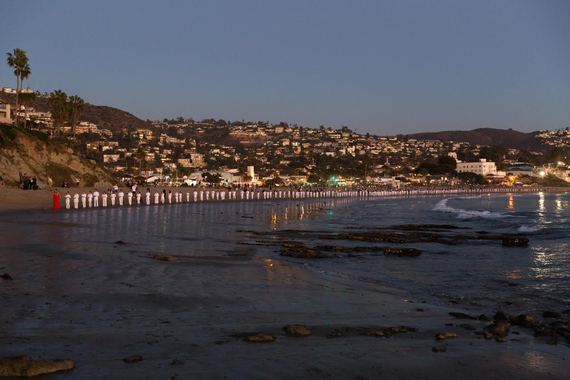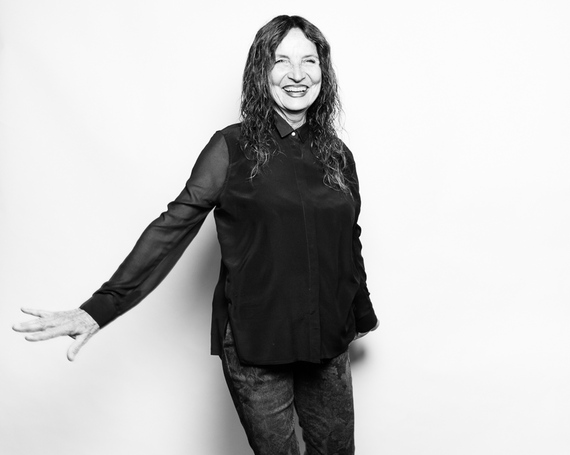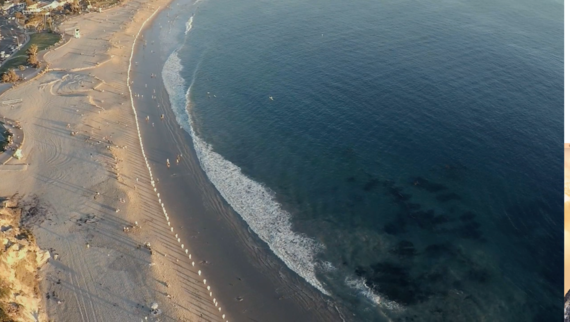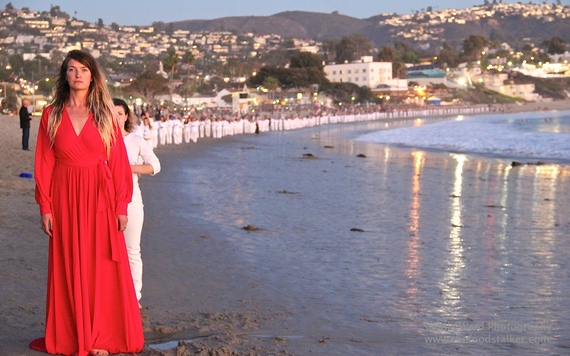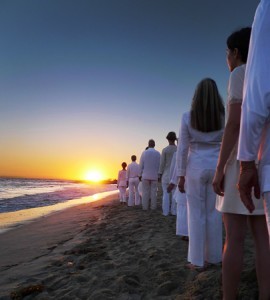Several moons ago, in November of 2014, I had the unique opportunity to perform in Lita Albuquerque's live art piece, "An Elongated Now," part of the Art & Nature Festival in congruence with the Laguna Art Museum and produced by the incredible Nicole Disson. Albuquerque's work can be categorized in many varying ways, but she's best known for her large-scale minimalist installations, encompassing bodies and nature. In "An Elongated Now" we walked down a rocky beach path from the museum, to the shore. I was one of 300 people standing in a massive line, all dressed in white and forming the world's largest human arc, reaching over 2,500 feet. We each stood in the sand holding a small blue light in front of the top of our rib cage, also known as our Solar Plexus Chakra. We turned on the blue light as Jasmine Albuquerque Croissant, drenched in a red flowing gown, walked past our bodies. Her movement in and out of the human arch, caressed our shoulders, and caused each of us to spin on our bodily axis, making a ripple effect down the line. Along the human arc a large blue rock rested every few feet in the sand, as we came to a standstill and allowed the sun to do what it does every evening, kiss the horizon.
Once the sun set, we walked in line back to the museum, where we entered a small gallery room, lit only by our individual blue lights. Lita spoke her thank you's, however the experience didn't end there. As a final act, we entered the next room which was projected with stars. The ground was blanketed with white sand and a blue body/sculpture appeared to levitate in the middle. The sound of a recorded poem written by Lita reverberated throughout the space. The entire experience was emotional and complex, as if being a part of a larger, grander scheme. I left wondering what each element in the art piece meant to Lita herself, and how that translated through our individual perspectives.
A week after this experience I sat down with Albuquerque in her Santa Monica, CA. art studio, which is an installation all of its own. Filled with many artifacts from her past works, collected and artfully arranged. Textural objects and bright colors filled the room, all creating a controlled chaos, including beehives in the shapes of continents beneath glass boxes. Albuquerque is as captivating as her unique work. She possesses an intelligent, loving and warm demeanor that leaves you feeling full after talking with her. It was such a joy getting to better know this remarkable woman. In the interview below, Lita reflects on "An Elongated Now," on her life, her art and her artistic journey, including some of what will transpire in future creations.
EVA: It was interesting being in [the performance], especially from an acting standpoint, especially after studying at CalArts, because a lot of our training was all about getting to this in-between, present, almost meditative state---how it feels and having an awareness between actions...the stillness of the space. [...] And when I was standing there on the sand, so many different things happened to me--all these different elements interacting like: little kids running around and people taking selfies, the waves crashing, drones flying overhead --
LITA: [laughter] They were telling me that people took selfies. Interesting to think that we, who were standing there, were thought of as landscape monuments to have a selfie taken in front of! [more laughter]
EVA: It was crazy--but fascinating, too, because the piece is all about presence and being in the moment...observing what is around you. I mean, I'm guilty of this, too, of course; being on my phone and not necessarily being fully present. So this was really...I just won't forget that experience.
The human arc and myself in "An Elongated Now" by photographer Sandie Ward
LITA: Oh great! Yeah, I think one of the most shocking things was when people would come up to me to ask questions and I couldn't understand why I wasn't responding to them. [laughter] And then somebody asked "Is this a wedding?" and I thought that was hilarious. What a great idea for a wedding!
[both laugh]
But, the relationship with the public was totally unexpected and it was wonderful. In all my other pieces I really kept the public away, and it was nice to see that kind of interaction--and it didn't seem to upset the piece at all. It added another element.
EVA: Yes, the audience ended up being a big part of it.
LITA: Yes! They were definitely a big part of it, and they didn't realize that they were a big part of it, which I thought was interesting. It shows you how we are all important. You know, I'm interested to hear what went on in your head during the performance.
EVA: Well there was so much going on around me, I kept focusing on my feet--my feet and their connection to the earth; my breathing---you know, anything to stay present in the moment. But I kept having these internal revelations about what I need to do in my life and things like that. Which was weird, because I don't think reflection like that is negative, but in the moment, I thought it was distracting and for some reason I just really wanted to focus on the moment, stay present. Then I'd turn my focus back to all of these people around me in the arch. When I did that I had the revelation that all of these people were brought together by one woman with a vision, and I found that extremely moving and powerful! It was incredibly inspiring for me.

The human arc and myself in "An Elongated Now" by photographer Sandie Ward
LITA: That's wonderful. For me, over the past couple of days--I live in Malibu, so I have to take the Pacific Coast Highway a lot--I'd see these vast expanses of beach and couldn't help but see hundreds of people and the white cresting waves. And now I can't look at waves the same way again without imagining people. So now I have this idea to have people dressed in a white line up at the edge of the continent from Tierra del Fuego in Chile all the way to Alaska, like a huge land drawing made up of people. And now I'm thinking about what that would represent; what it could mean? Does it matter? But, yes, I'm interested in the levels of things, things that people go through. Like when you we're telling me about all the things you were doing to stay in the moment, and how you were having these revelations that might not have happened had you not tried so hard to be present in the moment. But, yes, you can make these powerful things happen and I think that's really great.
EVA: Yeah, it was almost like meditation. It was so cold on the beach! I started to focus on the cold in my toes and it started growing and growing...
[laughter]
--from there over my whole body. [Laughs] And then I started to focus on my breathing again and I could kind of take control of the cold instead of it controlling me.
LITA: It's a great exercise [both laugh]. And it's so interesting to do that kind of exercise with so many people. I was looking at the pictures that were taken and---you know, I have no idea where peoples' heads were at obviously--but it was interesting to see that they seemed like they were trying to be in that space as much as possible.
EVA: Yes, and having the leaders helped a lot too. I felt that was a good feeling of security for everyone--like we were a good representation of the idea behind the piece. Everyone saw the leaders and thought that it was okay for all of us to be in this stance of calmness. It makes for such an interesting case study of people, too.
LITA: Yeah, yeah.
EVA: Could you tell us about what the piece represented?
LITA: Well, it represents so many things, but the initial initial idea was purely aesthetic -- visual. I just wanted to find out how to emphasize that beautiful arch of the beach, and to echo the cresting waves; but then it grew to be about how we are all inter-connected. In this case, I had a vision of people being a drawing on the land echoing the edge of the continent. But once I went to achieve that vision, it required hundreds of people, and it is the collective, the accumulation of individuals that made that image happen. What I mean is that each person is such an important linkage, that if one person goes out of step, it messes up the whole thing. And we just don't realize that in our lives, right? We don't realize how important we are as part of the whole. And a lot of times when I do my work people will say, "oh, it makes me feel so small--the way you think makes me feel so small in the cosmos," but for me it's just the opposite. It's like each person is such an important part of the link to the whole that it ends up being a great responsibility. So, on a whole other level, the piece is about that---the realization of who we are as humanity, a totality... You know, this idea I have to go from Chile to Alaska--why do it? To show the world and experience what it would be like to come into harmony with so many fellow humans over such a great distance. It reveals to us the importance of individuals at the same time as the importance of the collective.
EVA: Can you talk a little about your use of color?
LITA: Sure. Color has always been a hugely important thing for what I do. I studied color quite a bit and how it affects our entire organism, and that's why I like to use primary colors. But also vibrant and monochromatic colors--so that it makes an imprint in our minds. So that you can't--like for me, I can't go down to the beach without seeing that line of white, because of its iconic imprint. You know all the people in white in the project against the blue of the sea makes an imprint, a pattern in your brain--well, it's different for everyone.
EVA: What is the significance of blue?
LITA: Blue is the planet, the sky, it's elemental. It's the idea to unite the sky and the Earth. The German poet Goethe said, "We enjoy gazing upon blue not because it forces itself upon us, but because it draws us after it." It's like the horizon, something that we can't catch.
EVA: If you can, how would you describe yourself as an artist?
LITA: I can say that my life's trajectory has forced me to question my relationship to place and to space. And I feel that it's kind of like, the Pied Piper. My quest has been about Identity and my place in the world and in the cosmos. And that came out of this fierce wanting to...I grew up in North Africa--in Tunisia--and my father was in Paris. I only saw my father once and I always had this dream that he would appear to me in a boat on the horizon line--this thing, this desire to define him. And then, my mother, my brother and I immigrated out of the country and it never felt right, something felt missing. I realized I left something behind, this thing I had to find. My art is about trying to figure out what that thing is--if you look at that symbolically--who are we on this planet? There is this quest, this fierceness of wanting to connect with something bigger--if that answers your question at all [laughter].
So in the work, even if there's all these aspects that come in, like art history and education, there's this desire to find this placement. I go all over the place uniting people with these projects--and now I'm beginning to see that the trajectory can be really universal. I just saw Interstellar, have you seen it?
EVA: No, I haven't yet.
LITA: It's good, it's about similar things, but in a different way. It talks about a lot of issues that normally wouldn't be in films, but it's pretty good in terms of those kinds of questions. I find myself at an interesting time as an artist. People finally seem to be able to hear what I'm saying and it's very timely in terms of where we are. I can't find the word, it's not Pied Piper, but it's one person who represents a lot of who we are...
EVA: What is your idea of presence? Because, presence can be in physical form, but also your art work can have presence, too. Like the idea of essence; staying power.
LITA: Well obviously art is just that, right? Each piece--well especially minimal art has that kind of presence. The first thing that comes to mind is presenting an absence. But when you first mentioned it I thought of what you said about your performance class and your state of mind and body. I think I'm definitely in the same line of thinking as some scientists who think that things are vibrational and electromagnetic, so I think that the energy of objects and of beings is important for everyone and that, certainly as an artist who loves beauty, it is important to do work that affect people electromagnetically, phenomenologically, and that is transformative. So presence as an artist is really a manipulation of elements to get to a materiality that affects the immaterial. Like I look at you and I feel good, elevated [both laugh]. I think it's important for everyone to realize that if they can be their best, most beautiful, they affect the world and everyone positively. It goes back to the individual and whole, the one and the many. A lot of people don't realize how important they are to the whole. Presence is about being.... What did you mean by the question?
EVA: I'm just really interested in the different ideas of presence. Speaking of presence, the mural of you by Kent Twitchell, under highway 101 [in LA]; is there a story behind that?
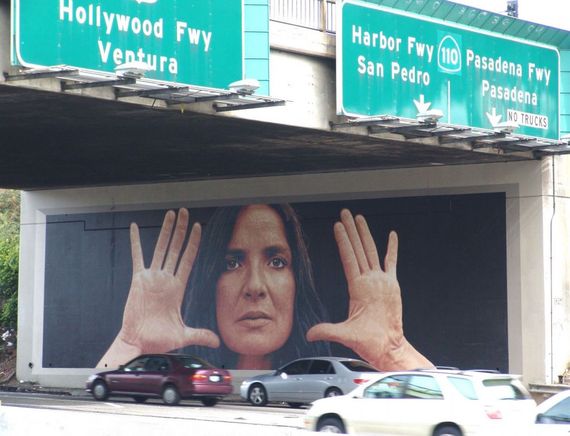
Mural of Lita Albuquerque by artist Kent Twitchell
LITA: Yes, there is! I was teaching at Otis Art Institute--this was 30 years ago, I was pregnant with my daughter Jasmine--and I was teaching there and Kent Twitchell asked if he could take my picture. He thinks artists are god and goddesses. And it's called the Altar Mural, he created it for the 1984 Olympics. The image went all around the world, too.
EVA: So cool. You studied at Otis, too, right?
LITA: I did. I think I was teaching at the time he did that, but I did study there. I love your question about presence--it's really making me think. It's huge.
EVA: Thanks! Why do you find yourself so attracted to working with nature?
LITA: It's my first inspiration, everything I do is inspired by it. I grew up in Carthage, this historical ancient Roman city on the coast of Tunisia. Everything is more powerful there--it's Africa. And I have always lived by the ocean. And I was really lucky, too; eventually I lived in this funky art colony in Malibu. It was there that I grew up as an artist and I noticed the Sun's motion from East to West and where the outlines of the mountain touch the sky. And so for me, my first relationship is to nature. And I run on the beach everyday and swim. Unfortunately most people have been separated from Nature. You have to see Interstellar! It's just-- we are so connected to Nature but we are losing that connection.
EVA: I do feel something is happening right now though, like something is starting to shift. Like we might be going back to our roots, in more and more mysterious ways...
LITA: Like what?
EVA: Well, for instance, in your piece, bringing all these people together to be still in nature. I was listening to a podcast on SoundCloud, someone was talking about meditation and he was saying how it's so powerful and that the more people are doing it in one place the stronger it is. And it's a fantastic idea-- say we got thousands of people to get together somewhere--say the Middle East--and just meditate around or on it and maybe the circumstances there could be better, just from that stillness/energy that we all obtain. I feel the more talk of these ideas trigger something else and something else--it's just not your everyday, in-the-box thinking.
LITA: You know the media dumbed us down so much and now people are speaking out. My husband likes to say that governments are terrible, but that people are wonderful--and it's true everywhere you go--it's the governments, but it's the people themselves coming together and doing things more and more. And those things do help. I remember the first time I went to India, in 1988, and what came out of that for me was this phrase that I wrote... it goes, "it takes a thousand masters praying to melt one heart of stone," the reason I came up with that is, because I heard that praying, that chanting everywhere. And that's what it takes.
EVA: Beautiful. What artists are you inspired by?
LITA: ... Hmmm... I'm inspired by a lot of artists. Let's begin with architecture; like the Pyramids, Ancient Egypt. Another big influence is Islamic art. Going forward there's the pre-Renaissance painters that used a lot of gold, red and blue--like Giotto. This combination of blue, red and gold is both in Renaissance art and Islamic art. And then at the beginning of the 20th Century; people like Malevich and Kandinsky...and Mondrian. And then all the minimalists--I love minimalism. I was very affected by Robert Irwin and his sense of space. Before knowing about him I was a painter, I heard him lecture a lot and I was affected by how stretching a black line in the middle of a white gallery, it transforms into two volumes. I was fascinated by this line. I like Land Art--coming from a desert country. The idea of placing color on the whiteness of a dry lake bed. Then huge influences from theater--Robert Wilson is one of my favorites. Philip Glass is huge for music; Pina Bausch for dance. You know all the greats [laughter]. You know it goes on and on. And film, of course.
EVA: Speaking of lake beds, have you heard of Jim Denevan?
LITA: Yes! Yes, I have and you know the reason I heard of him was that he was the artist who was commissioned the year before me, before "An Elongated Now," at the same Art and Nature Conference.
EVA: My friend, Meredith Danluck, is a filmmaker and she documented his work in Siberia. He made the largest art piece of circles in a dry lakebed. Her film's called, Art Hard, it's pretty amazing.
LITA: His work and the scale at which he works is just amazing.
EVA: Do you strive for the same type of natural canvas?
LITA: Yes, definitely. You know, like the piece I am envisioning from Chile to Alaska, for my next project at the salt flats in Bolivia. When it rains, there, the salt flats perfectly reflect the sky. I am planning to do a 24-hour piece, similar to "An Elongated Now."
EVA: When you have these ideas, how do you begin the process?
LITA: Oh God...[both laugh]...well, I've always--there was a point in my career where I decided to commit my work to be about the relationship between the Earth and the Sky. I wanted to do star maps on the earth that would reflect the stars above. I started out with the idea of creating these "star" maps at the North and South Poles--at the time no one was even talking about the poles and it was extremely difficult to get there, then I found out that there are grants from different foundations. So sometimes I get grants and do research or sometimes I get commissioned, like the project in Laguna, "An Elongated Now." But, it really just comes down to funding. Like Bolivia, I've just received a Santa Monica Arts Commission Artist Fellowship which will permit me to go there and do research for the project.
EVA: Do you have any assistance with doing research and finding grants?
LITA: I do have two amazing assistants. One in the studio, Kyomi, and one who does everything else--Marc-- and we do it all, just the 3 of us, but it would be best to have a whole team. And I also do studio and gallery work and get funds from that, but it's hard to get funding for really big projects. I mean it was so great--The Getty Museum a few years ago--"Spine of the Earth 2012". It was in this park that looked like a temple and I had 300 people dressed in red initially forming a spiral around a skydiver who landed on top of the mountain then went down 287 steps, down the mountain to form a red "spine" in the Earth.
EVA: Wow, that sounds amazing. Now that you mention red, it reminds me of your daughter Jasmine's dress in "An Elongated Now." Do you two collaborate often?
LITA: Yes, we do. I mean, there's certain things that I don't do and certain things she doesn't do, but yes, when we collaborate it's great. This year [2015] she performed in three of my pieces and next year she will be the subject of a video -- I am working on for USC Fisher Museum. But, yes, I do want to keep doing these large projects that involve collaborations and many performers with social elements.
EVA: Very cool. You also had the opportunity to collaborate with Cesar Pelli, one of my Dad's favorite architects. How was that experience?
LITA: Yes, we collaborated on a library in Minnesota. I've done a lot of collaborations with architects, that one I wasn't that involved in. It was more, a lot of different artists participated and it was just his vision for the building.
EVA: What draws you to working with architects?
LITA: Well I love working with space. And you know, I love the way they think, the type of education that they have...I, again going back to presence, I totally know that our thinking changes according to the architecture we are in and the importance of architecture and I think I'm gonna be an architect in my next life. [Laughter] You know, I've always had a lot of friends who are architects and I just love---I think it's a certain mentality--and they're drawn to me, to which is interesting. I just like the intersection between art and function.
EVA: Will you read the poem you wrote for Elongated Now?
LITA: Sure, I wrote it on the New Year's Eve between Milleniums and this is what I wrote:
I see beings of planet Earth arriving one by one in silence
A shared rondevu at the stroke of midnight of the year 2000 A.D.
Skating on icicles of starfields
Feet in stardust
Their bodies spun in geometric and numerical sequencing
Aligned at the mythic horizon
They watch come in what they have always known
Stamped in the light of their souls memory
And in the darkness of nights remembrance
The immensity of their togetherness
The agreement of their stending
At the horizon
Side by side
Sensing the first shiver
The first fluter of the opening of the heart
And this is something I could see happening or see myself doing at the Bolivian Salt Flats. So I did imagine seeing hundreds of people dressed in white all along the flats.
EVA: Why white?
LITA: I don't know. I just love that kind of, out of time-ness. A mysterious arrival, skating on stardust...the immensity of their togetherness, standing together side by side...and I think it's happening, I know it's happening--that thing you were talking about. That return. It's exciting. I think we're getting to know who we are and we are that togetherness! Our shared humanity. And this will take us someplace. When I was little I had this idea that humanity had an image they had forgotten and that we need to dig into ourselves to find it. We are in need of a new story, a story that connects us to the cosmos. And a lot of what I do is striving to write this new story. A new story through the heart. I know that I'm part of this wave, this Pied Piper. It's happening so much in your generation. Your whole generation is so creative.
EVA: I agree. It's really incredible. Especially the idea of surrounding yourself with art---that's more prevalent. The elements of technology and art are really there to help bring that special awareness to people. Even with your Chile to Alaska piece, it's now possible to bring people together and spread awareness about this idea through the platform of social media.
LITA: Right! Like Twitter! [both laugh]
EVA: Yes! Well, thank you so much Lita, this was wonderful.
LITA: Thank you, it was my pleasure. I feel like we're good friends now. [laughter]
